Shinobi iri
Shinobi iri means silent moving forward and is a way of avoiding a fight. The Ninja knew various Ninja aruki (step techniques) to move silently, unseen, or quickly. Here are some of the steps used:
Overview of the Techniques
- Nuki ashi (silent step)
- Ō ashi (big step)
- Ko ashi (small step)
- Ko kizami (short step)
- Wari ashi (adaptive step)
- Tsune ashi (normal step)
- Shime ashi (firm step)
- Yoko aruki (sideways walking)
- Ayumi ashi (normal walking forward)
- Nami ashi (take a step)
- Mae ashi (forward)
- Ushiro ashi (backward)
- Yoko ashi (aside)
- Naname ashi (sideways)
- Hiraki ashi (side-sliding)
- Okuri ashi (the following step)
- Suri ashi (put on behind, front in front)
- Yori ashi (simultaneous gliding)
- Tsugi ashi (front in front, pull behind)
- Tobi ashi (flying step)
- Mae tobi (to the front)
- Ushiro tobi (to the back)
- Yoko tobi (aside)
- Nidan geri (double kick)
- Sashi ashi (cross-step)
- Mae ashi (forward)
- Ushiro ashi (backward)
- Yoko ashi (aside)
- Ashi fumi kae (change legs)
- Tenkan ashi (turning step)
- Chakuchi (lunge)
- Mae chakuchi (forward)
- Ushiro chakuchi (backward)
- Yoko chakuchi (aside)
- Chōkyori kyōsō (long-distance running)
- Heipo (The Way of the Salamander)
Techniques in Detail
Nuki ashi – Silent Step
This technique allows the Ninja to move silently over wooden planks or straw mats. He has total control over his body weight. From a low position, balance and body weight are slowly transferred to the front leg until all weight is on the leg. Then the back leg is pulled. The ankles almost touch. The weight is slowly transferred to the foot. This way the Ninja can withdraw the foot as soon as he hears a sound.
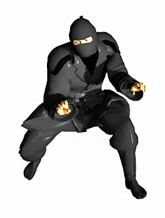
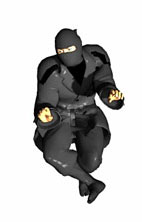
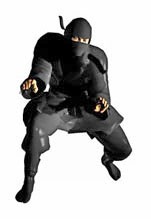
Chōkyori kyōsō – Long-Distance Running
This running method was the basic method of all Ninja, but it was adapted by each individual runner to their own build, stride length, and arm position.
The runner keeps the torso upright, the head straight, and fixes on a point about 10 meters in front. The foot is placed with the outer edge of the heel and rolled forward. An important factor in running long distances is breathing. To do this, the Ninja used diaphragmatic breathing and maintained a constant pace throughout the course.
Some stories say Ninja were able to travel the 560 km between Edo (Tōkyō) and Osaka in three days.
Ko ashi – Small Step
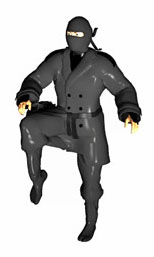
This small, stabbing step is used when one needs to walk through shallow water or leaves without making a sound. From a hip-dropped position with the weight on the front foot, the Ninja pulls the back foot behind and pulls it up. Then he holds it over the spot where he wants to lower his foot, he carefully touches the spot with the tip of his foot, when the spot is safe he lowers his heel. This pose resembles a crane making its way through the wilderness.
Yoko aruki – Lateral Walking
This technique is used to move quietly in the shadows of buildings or corridors. The hips are aligned laterally to the target of the movement. Weight is shifted to the front foot and the back foot is placed in front of the front foot. The body weight is shifted and the back foot is placed forward in its new position. The movement is performed smoothly and smoothly, resembling a crab moving sideways along the beach.
Sometimes a standing movement is no longer possible, then the Ninja has to crawl.
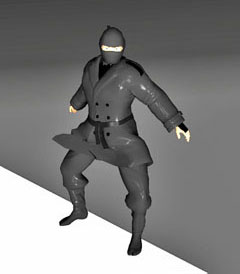
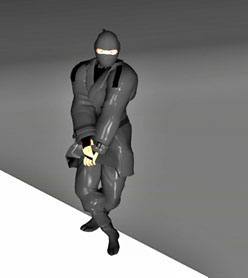
Heipo – The Way of the Salamander
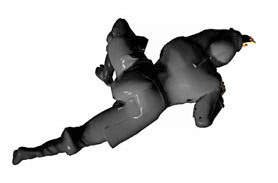
This technique allows the Ninja to move completely silently over a short distance. The Ninja lies flat on the ground and moves only on the palms and toes. Instead of the palms, this technique can also be performed on the fingers.
The arms must be as close to the body as possible to save energy. The further the arms are spread from the body, the more strength is required.
The body weight rests on the right palm and the tip of the right toe. This happens with locomotion in rhythmic alternation, similar to a salamander.
Because the Ninja only ever has four points of contact with the ground, noise can be easily avoided.
Training
To start training silent movement, first, observe nature and how noise is made. One should take a lot of time to observe which sounds work in which ways, which helps to mask sounds, how one’s own movements and the movements of others work. Noises (such as door noises, foot noises, wind, etc.) that are otherwise hidden by the subconscious should also be observed during the exercise.
Now that you know how noise is made, just make sure you don’t make it. After that, training begins on boards, leaves, grass, gravel, etc.
According to Stephen K. Hayes, laying out a few layers of wet newspaper on the floor is particularly effective. If you didn’t walk properly, you can tell by the creases and folds in the newspaper surface.
The following list may help you learn the techniques:
- To maintain control of balance, the bodyweight is lowered while the knees are slightly bent.
- Do not forget to breathe during the movement. Breath-holding causes unnecessary muscle tension, which affects balance.
- Keep an eye on the entire movement while moving. Don’t just look at your feet and no longer notice other people or buildings.
- Use all joints for movement. Don’t stiffen your knees and swing the whole leg from the hip as a solid object!
- Throughout the movement, keep your weight on the foot that is on the ground. Avoid putting weight on both feet.
- Keep your arms at different heights next to your body so that a disability can be identified immediately.
- If there is too much noise, take a break and listen to your surroundings. Then lower your hips a little lower, relax completely, breathe in deeply and breathe out slowly during the movement.
- Have as much patience as possible. If speed is not essential, take as much time as necessary. Inattention results in violent movements that are easy to hear.
- Always adapt the movements to the environment. In some areas, total silence may even be noticeable and a crack in the planks now and then is only natural. Then adapt the movements to the natural cracking sound.